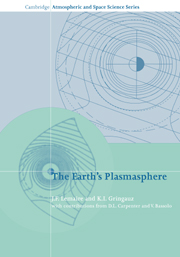Book contents
- Frontmatter
- Contents
- Preface
- Foreword
- Dedication
- Introduction
- Chapter 1 Discovery of the plasmasphere and initial studies of its properties
- Chapter 2 Electromagnetic sounding of the plasmasphere
- Chapter 3 Plasmasphere measurements from spacecraft
- Chapter 4 A global description of the plasmasphere
- Chapter 5 Theoretical aspects related to the plasmasphere
- Epilogue
- References
- Index
Introduction
Published online by Cambridge University Press: 24 November 2009
- Frontmatter
- Contents
- Preface
- Foreword
- Dedication
- Introduction
- Chapter 1 Discovery of the plasmasphere and initial studies of its properties
- Chapter 2 Electromagnetic sounding of the plasmasphere
- Chapter 3 Plasmasphere measurements from spacecraft
- Chapter 4 A global description of the plasmasphere
- Chapter 5 Theoretical aspects related to the plasmasphere
- Epilogue
- References
- Index
Summary
The plasmasphere is the vast ‘doughnut’ shaped region of the magnetosphere that is filled with trapped ions and electrons of ionospheric origin; their energy is less than 1–2 eV. These charged particles are trapped on geomagnetic field lines, forming a cold thermal plasma cloud around the Earth out to geocentric equatorial distances of 4–5 Earth radii (RE).
The outer boundary of the plasmasphere forms a rather characteristic ‘knee’ in the equatorial plasma density profile. This field-aligned surface is called the ‘plasmapause surface or region’, or more simply the ‘plasmapause’. The plasmapause was discovered in the 1960s independently from in situ space probe measurements and from ground-based whistler observations. A first-hand account of the history of this discovery of the boundary is presented in Chapter 1. In the first part of this chapter K. I. Gringauz reports the prevailing situation in the former USSR, his design of the first ion traps flown in outer space and how he had to fight to get his experimental findings published and accepted in his country as well as in the Western World. In the second part of Chapter 1, D. L. Carpenter describes the situation in the US and the history of his discovery of the plasmapause from dynamic spectrograms of whistlers.
Whistler waves are audio frequency radio waves produced by lightning in the atmosphere. They propagate back and forth along field-aligned plasma density irregularities in the magnetosphere. Their travel time from one hemisphere to the magnetically conjugate point in the opposite hemisphere is mainly determined by the electron concentration in the distant magnetosphere where the VLF waves cross the geomagnetic equatorial plane.
- Type
- Chapter
- Information
- The Earth's Plasmasphere , pp. xvii - xxiiPublisher: Cambridge University PressPrint publication year: 1998



